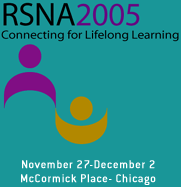
Abstract Archives of the RSNA, 2005
Matthew B Morgan MD, Presenter: Nothing to Disclose
Barton F. Branstetter MD, Abstract Co-Author: Nothing to Disclose
David M. Lionetti BA, Abstract Co-Author: Nothing to Disclose
Paul Joseph Chang MD, Abstract Co-Author: Nothing to Disclose
The volume of patient data has steadily increased as greater numbers of diagnostic tests have become available. Clinicians may have difficulty extracting critical information, and important radiology findings may be overlooked if reporting and messaging mechanisms are not optimized for context. The purpose of this report is to describe three context-specific models for communication of radiologic findings, and to demonstrate the software tools that we have developed to facilitate this communication.
Positive radiology findings can be grouped into three categories: 1) emergent findings that require immediate action (e.g. airway compromise), 2) urgent findings that require prompt attention (e.g. retropharyngeal abscess), and 3) non-urgent positive findings that require attention in weeks or months (e.g. pulmonary nodule). To optimize the mode of communication in each of these categories, we assessed the requirements for 1) signal to noise ratio, 2) clinician attention level, and 3) communication channel reliability. We then developed software to provide optimized, context-specific reporting and messaging mechanisms for each type of radiologist-to-clinician communication.
For emergent findings, a preliminary report database was developed that allows input by radiology residents or clinicians. The input and display interfaces are deeply integrated with the PACS, so that reports are available throughout the enterprise. For urgent findings, a relationship-rich directory tool was integrated into the PACS to help facilitate synchronous communication with referring clinicians. For non-urgent findings, a web-based radiology portal was developed, allowing clinicians to access a list of their patients’ reports. Using natural language processing, reports containing important findings for follow-up are automatically highlighted to attract the clinician’s attention.
Positive radiologic findings with different levels of urgency should be communicated to clinicians in different ways. Optimized, context-specific software solutions are needed to provide reliable, efficient communcation of radiology results in various clinical settings.
M.B.M.,B.F.B.,D.M.L.,P.J.C.: Laboratory support from Stentor, Inc. DARPA NLM NIH US Air Force
Morgan, M,
Branstetter, B,
Lionetti, D,
Chang, P,
Optimized Communication Models for Radiology Reports: Helping Clinicians Cut to the Chase. Radiological Society of North America 2005 Scientific Assembly and Annual Meeting, November 27 - December 2, 2005 ,Chicago IL.
http://archive.rsna.org/2005/4410305.html

